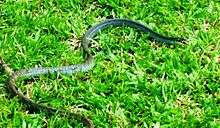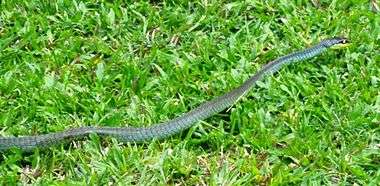Dendrelaphis calligastra
| Dendrelaphis calligastra | |
|---|---|
 | |
| Scientific classification | |
| Kingdom: | Animalia |
| Phylum: | Chordata |
| Class: | Reptilia |
| Order: | Squamata |
| Suborder: | Serpentes |
| Family: | Colubridae |
| Genus: | Dendrelaphis |
| Species: | D. calligastra |
| Binomial name | |
| Dendrelaphis calligastra (Günther, 1867) | |
Dendrelaphis calligastra, the northern tree snake (also called beautiful-bellied tree snake) is a slender, large-eyed, nonvenomous, diurnal snake. It grows up to 1.2 m in length and is greenish, brown, or greyish above with a cream or yellow belly.[1]
This common snake is harmless, and readily recognised due to its cream to yellow belly and pronounced wide dark facial stripe passing across the eye.[2][3]
Etymology
Dendrelaphis: 'tree Elaphe', after another genus of colubrid snakes. calligastra: 'beautiful-bellied'.[4]
Habitat
Northern tree snakes are found in tropical north Queensland, from Paluma to Cooktown and eastern Cape York Peninsula, as well as southern Papua New Guinea. They live in a wide variety of habitats, including rainforest, urban and farmed regions, and open forest. They often bask in the leaf canopy of small bushes and trees and can escape very quickly through the canopy.
Diet
They eat frogs and reptiles.
Distribution

Dendrelaphis calligastra is common in Queensland's northern tropics and eastern Cape York Peninsula.
Breeding
The northern tree snake lays eggs in clutches from five to seven, with one female recorded as laying 11 eggs in January.[5]
References
Further reading
- Queensland Museum (2000). Wildlife of Tropical North Queensland: Cooktown to Mackay. ISBN 0-7242-9349-3
- Ehmann (1992). Encyclopedia of Australian Animals: Reptiles. Harald Ehmann. The Australian Museum. Angus & Robertson. ISBN 0-207-17379-6 (Reptiles).
